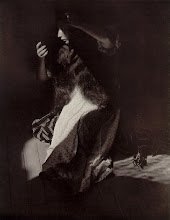Nicholas Byrne - Divider

Nicholas Byrne is an artist who loves paint. His previous shows at Vilma Gold and Kerlin Gallery were full of images of fragmented figures, composed of explosive colour, broken brushwork, intricate design work and layers of paint. So when he was presented with the opportunity to create whatever he felt like for Studio Voltaire’s converted community hall, he went a little crazy and made a huge, ironwork sculpture. That’s not to say that there aren’t any paintings, in fact there are four, but it’s the sculpture that really hits you as you step into the specially transformed gallery space, complete with cream-painted floor
After graduating from the Royal College of Art in 2005, Byrne has been a busy man with exhibitions all over the place, and his work is no quick feat with some paintings taking in excess of a year to complete. In previous work, he demonstrated an interest in the dialogue between form and design, chance and intent, using the human figure as a basis for this conflict. And so his first foray into the realms of sculpture is perhaps only natural progression. But at the same time, despite the works immense size, dividing the space in two, he chooses to keep things two-dimensional and paradoxically painterly, echoing the forms of his paintings on a much larger scale. No longer content to fragment his figures in paint, Byrne projects the effect onto us. Except we don’t immediately realise it, because it’s only other people we can see trapped within the lattice-like mesh. And what’s more it’s much easier for us to be free of the sculpture’s grasp; simply turn through ninety degrees and we’re no longer aware of its presence.
As for Byrne’s painted victims, they’re not so fortunate. Trapped in layers of heavy paint on copper and linen, they become symbolic of their attempts to conquer the space around them. Continuing Byrne’s trend of makeshift display, the paintings lean almost incidentally against the gallery’s whitewashed walls, providing a dramatic counterpoint to the vastness of the sculpture. In his previous show at Kerlin Gallery, Byrne addressed the issue of identity with images halfway between figuration and abstraction and in some ways ‘Divider’ continues this exploration. Only this time round, there’s additional depth in the form of narrative. The four paintings read from left to right appear to convey four different moments during a race, from the warm-up to the finish.
Representation of physical prowess has always been a challenge to artists. There are a number of varying approaches to this from the austere photography of athlete’s captured in time à la Herb Ritts to the more drastic breakdown of space in paintings à la Italian Futurism. Byrne’s works seems to fall between the two. Perhaps taking his cue from the recent Olympics, his figures are athletes at their most extreme: focused and adrenalin fuelled.
A figure stretches from the intense orange of the canvases lower half to bright blue in the upper, as if reaching for the sky. Liberated? Maybe, maybe not. It is only for a brief moment. Another is accompanied by the image of a propeller which suggests the act of winding and made me think of stretching or of working yourself up before the race. But its effect cannot be sustained. Ultimately the athlete returns to stasis as Byrne makes use of the unpainted copper to represent a body once more contained within a restrictive background. The world continues to move. The figure remains still. Turn back to the sculpture and the same principle applies; this dynamic interplay between movement and stasis which stands as testament to the complexity of Byrne’s work.

There are definite echoes of European Modernism in his work, ranging from the Italian Futurism of Umberto Boccioni to the ruthless deconstruction of the human figure in the work of Francis Bacon. But Byrne doesn’t fall into pastiche. His work draws inspiration from tradition, but considers a different angle. It is playful, but underlined by both a viscerally and intellectually arousing exploration of the limits of painting and experience. Continual striving is met with continual conflict, but Byrne’s work reminds us that the race itself is half the fun.



0 comments:
Post a Comment